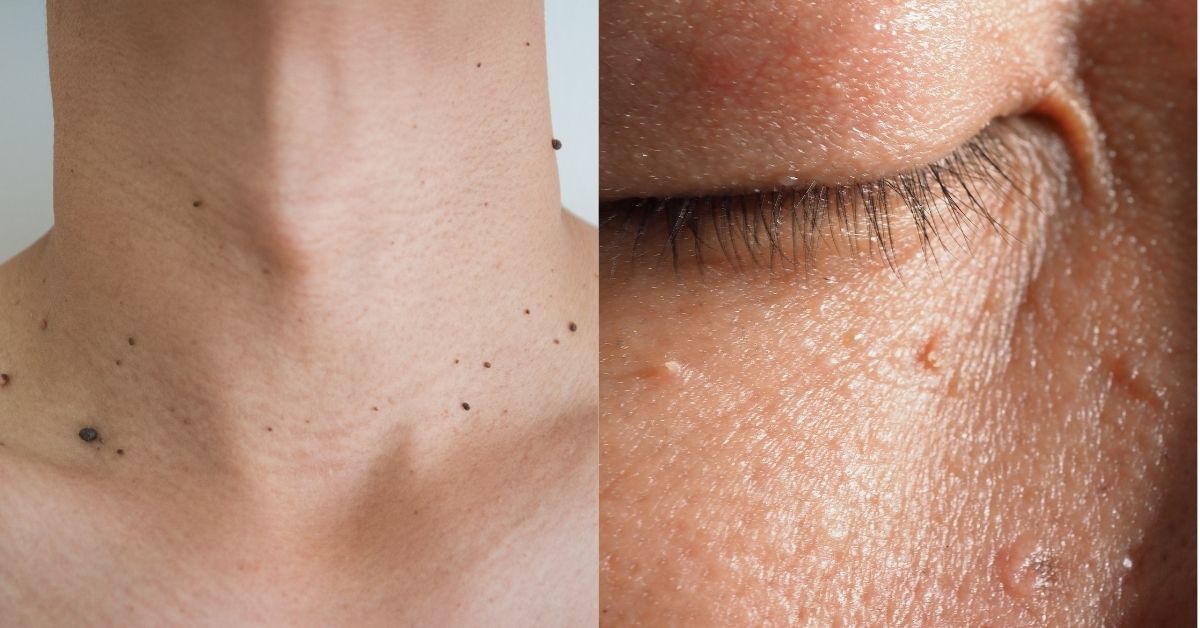
-
Posted By drruby.Sachdev@gmail.com
-
-
Comments 0
Table of Contents
Introduction
Understanding the difference between skin tags and genital warts is crucial for proper identification and treatment. Both conditions affect the skin, yet they have distinct characteristics, causes, and treatments. In this guide, we will delve into the topic of “Skin Tags vs Genital Warts,” helping you differentiate between the two, explore their respective causes, symptoms, and treatment options, and clarify when to seek medical advice.
Skin tags are benign skin growths that commonly appear in areas where the skin folds, such as the neck, armpits, and groin. They are typically harmless but can be bothersome if they become irritated. On the other hand, genital warts are caused by certain strains of the human papillomavirus (HPV) and are considered a sexually transmitted infection (STI). These warts appear in the genital and anal regions and can be a source of discomfort and concern.
Throughout this blog, we will provide a detailed examination of skin tags and genital warts, covering their causes, symptoms, and treatment options. We will also highlight the key differences between skin tags and genital warts, offering insights into their visual and physical characteristics, causes, risk factors, symptoms, complications, and treatment approaches. By the end of this guide, you will have a comprehensive understanding of skin tags vs genital warts and be better equipped to identify and manage these conditions.
Understanding Skin Tags
What Are Skin Tags?
Skin tags, also known as acrochordons, are small, benign growths that appear on the skin’s surface. They are typically flesh-colored or slightly darker and have a soft, smooth texture. Skin tags can develop on various body parts, including the neck, armpits, eyelids, and even private parts such as the genital area. These growths are attached to the skin by a thin stalk, making them appear as tiny, hanging bits of skin.
Causes of Skin Tags
The exact cause of skin tags is not fully understood, but several factors can contribute to their formation:
- Friction: Repeated rubbing of skin against skin or clothing can lead to skin tags. This is why they commonly appear in areas like the neck, armpits, and groin, where there is frequent friction.
- Genetics: A family history of skin tags increases the likelihood of developing them, indicating a possible genetic predisposition.
Hormonal Changes: Hormonal fluctuations during pregnancy can trigger skin tags. This is particularly notable as the body undergoes significant changes, which can lead to the formation of these benign growths.
Symptoms and Appearance
Skin tags are usually painless and asymptomatic. They appear as small, soft, and fleshy growths attached to the skin by a thin stalk. Typically flesh-colored, they can vary slightly in color, sometimes being darker. While they are generally harmless, they can become irritated if caught on clothing or jewelry, leading to discomfort.
Diagnosis and Treatment
Skin tags are diagnosed through a physical examination by a healthcare professional. Treatment options for skin tags include:
- Cryotherapy: Freezing the skin tag with liquid nitrogen, causing it to fall off after a few days.
- Excision: Cutting off the skin tag with a sterile blade. This is a quick procedure often done in a doctor’s office.
Cauterization: Burning the skin tag using electrical energy, which destroys the tissue and removes the tag.
Understanding Genital Warts
What Are Genital Warts?
Genital warts are small, flesh-colored or gray growths that appear in the genital area. They are caused by certain strains of the human papillomavirus (HPV) and are considered a sexually transmitted infection (STI). Genital warts can affect both men and women and are commonly found on the genital skin, including the penile shaft, scrotum, vulva, and vaginal walls.
Causes of Genital Warts
Genital warts are primarily caused by HPV, specifically strains 6 and 11, though other strains can also contribute. HPV is transmitted through skin-to-skin contact during sexual activity, including vaginal, anal, and oral sex. Factors that increase the risk of developing genital warts include having multiple sexual partners, a weakened immune system, and engaging in unprotected sex.
Symptoms and Appearance
Genital warts may appear as small, flesh-colored bumps or have a cauliflower-like appearance. They can be single or multiple and may cluster together in a localized area. These warts are usually painless but can cause itching, discomfort, or bleeding, especially during sexual intercourse.
Diagnosis and Treatment
Diagnosis of genital warts involves a physical examination by a healthcare professional. The appearance of the warts is typically distinctive, but additional tests may be conducted to confirm the presence of HPV and determine the specific strains. Treatment options for genital warts include:
- Topical Medications: Prescription creams or solutions containing chemicals such as imiquimod or podophyllin to help remove warts.
- Cryotherapy: Freezing the warts with liquid nitrogen to destroy the affected tissue.
- Surgical Removal: Excision or laser treatment to physically remove the warts.
Prevention and Vaccination
Preventing genital warts involves practicing safe sex, including the consistent use of condoms during sexual activity. Vaccination against HPV is highly effective in reducing the risk of genital warts and other HPV-related complications, such as cervical cancer. The HPV vaccine is recommended for both males and females, ideally before becoming sexually active, to maximize its protective benefits.
Skin Tags vs Genital Warts
Understanding the difference between skin tags and genital warts is essential for proper identification and treatment. Skin tags are benign growths that often result from friction or hormonal changes, particularly during pregnancy. In contrast, genital warts are caused by certain strains of the human papillomavirus (HPV) and appear in the genital area. Proper diagnosis by a healthcare professional ensures the correct treatment approach for each condition.
Key Differences Between Skin Tags and Genital Warts
Visual and Physical Differences
Skin Tags: Skin tags are soft, flesh-colored growths that typically appear on areas where the skin folds or rubs together. They are often attached to the skin by a thin stalk or peduncle, giving them a hanging appearance.
Genital Warts: Genital warts are flesh-colored or gray growths that can have a cauliflower-like appearance. They are usually raised and may appear as single bumps or in clusters on the genital or anal areas. Unlike skin tags, genital warts are not typically attached to the skin by a stalk.
Causes and Risk Factors
Skin Tags: The exact cause of skin tags is not fully understood, but they are thought to develop due to friction between skin surfaces, genetic predisposition, and hormonal changes such as during pregnancy.
Genital Warts: Genital warts are caused by infection with specific types of the human papillomavirus (HPV), particularly strains 6 and 11. HPV is transmitted through skin-to-skin contact during sexual activity, including vaginal, anal, and oral sex. Risk factors for genital warts include multiple sexual partners, a weakened immune system, and engaging in unprotected sex.
Symptoms and Complications
Skin Tags: Skin tags are generally asymptomatic and do not cause pain or discomfort unless they become irritated by clothing or jewelry. They are considered benign and harmless.
Genital Warts: Genital warts may cause itching, discomfort, or pain, especially during sexual intercourse. They can also bleed or become inflamed. In some cases, genital warts can lead to emotional distress due to their appearance and association with sexually transmitted infections.
Treatment Approaches
Skin Tags: Treatment for skin tags is typically elective and may include cryotherapy (freezing), excision (cutting), or cauterization (burning). However, many people choose not to remove skin tags unless they are bothersome or cosmetically undesirable.
Genital Warts: Treatment for genital warts focuses on removing visible warts and reducing the risk of recurrence. Options include topical medications (e.g., imiquimod, podophyllin), cryotherapy (freezing with liquid nitrogen), and surgical removal (excision or laser treatment). Treatment may also involve addressing the underlying HPV infection.
Expert Insights from Dr. Ruby Sachdev
1. Common Misconceptions
Many people confuse Skin Tags vs Genital Warts due to their similar appearance. Skin tags are benign growths that often occur in areas of friction, while genital warts are caused by specific strains of the human papillomavirus (HPV) and are considered a sexually transmitted infection (STI). Dr. Ruby Sachdev emphasizes the importance of accurate diagnosis to ensure appropriate treatment. Misdiagnosing a wart or skin tag can lead to ineffective treatments and persistent issues.
Dr. Sachdev’s Expert Opinion:
Dr. Ruby Sachdev highlights that while skin tags are generally harmless and asymptomatic, genital warts require medical attention due to their potential complications and association with HPV. Accurate diagnosis by a healthcare professional is crucial to distinguish between these two conditions and determine the appropriate treatment plan.
2. When to Seek Medical Advice
It is crucial to seek medical advice if you are unsure whether you have a skin tag or a genital wart. Dr. Ruby Sachdev advises consulting a doctor if you notice any changes in the appearance of a skin tag or wart, such as size, color, or discomfort. Prompt medical evaluation ensures that you receive the correct diagnosis and treatment.
Importance of Accurate Diagnosis and Treatment:
Accurate diagnosis of Skin Tags vs Genital Warts is essential to avoid unnecessary worry and ensure proper management. Healthcare professionals can perform a thorough examination and may recommend additional tests, such as biopsy or HPV testing, to confirm the diagnosis. Treatment plans vary significantly between skin tags (often elective) and genital warts (often requiring medical intervention), underscoring the importance of seeking professional medical advice.
Conclusion
Understanding the difference between skin tags and genital warts is essential for effective treatment and management. While skin tags are benign and generally harmless, genital warts require medical attention due to their association with HPV. If you have any concerns about skin growths, consult a healthcare professional for an accurate diagnosis and appropriate treatment. By following expert advice and preventive measures, you can maintain healthy skin and overall well-being.
Frequently Asked Questions
Genital skin tags are not typically considered a sexually transmitted infection (STI). Skin tags, including those in the genital area, are benign growths caused by friction or rubbing of the skin. They are not caused by sexually transmitted viruses like HPV, which causes genital warts.
No, warts and skin tags are not the same. Warts are caused by infection with the human papillomavirus (HPV) and can appear anywhere on the body, including the genital area. They often have a rough texture and may be raised or flat. Skin tags, on the other hand, are benign growths that typically occur in areas where the skin folds or rubs together. They are soft, flesh-colored, and often attached to the skin by a thin stalk.
HPV does not typically cause growths that resemble skin tags. HPV infections in the genital area usually present as genital warts, which can vary in appearance from small bumps to larger clusters with a cauliflower-like texture. Skin tags are unrelated to HPV and are caused by different factors such as friction and genetics.
It is not recommended to use wart remover products on skin tags. Wart removers are designed to treat warts, which are caused by a viral infection (HPV). Skin tags are benign growths and are typically treated differently, such as by cryotherapy (freezing), excision (cutting), or cauterization (burning). Using wart remover on skin tags may not be effective and can lead to irritation or damage to the surrounding skin.
Yes, genital warts are contagious. They are caused by specific strains of HPV that are transmitted through skin-to-skin contact during sexual activity. Practicing safe sex, including the consistent use of condoms, can help reduce the risk of HPV transmission and genital warts.


